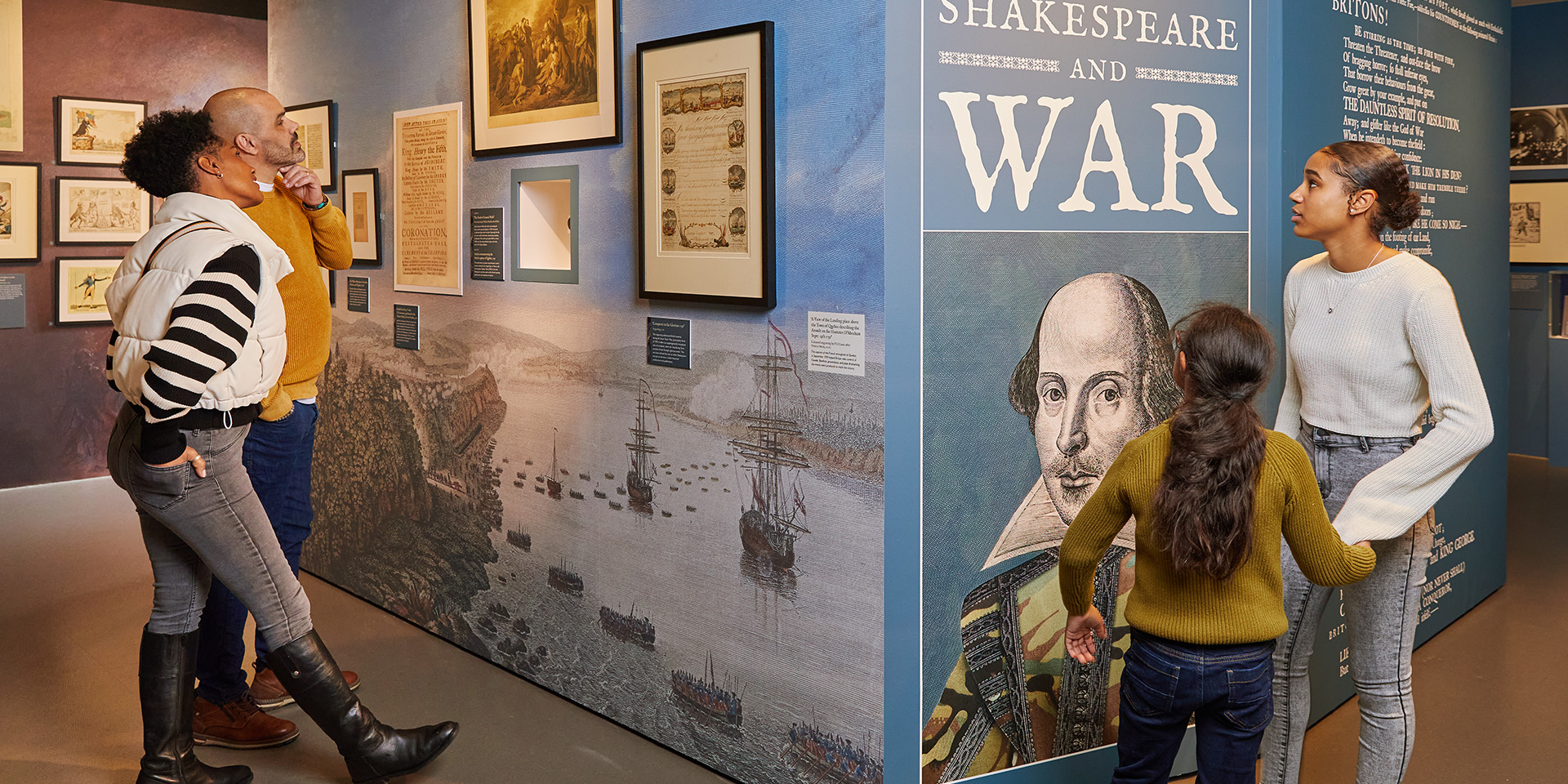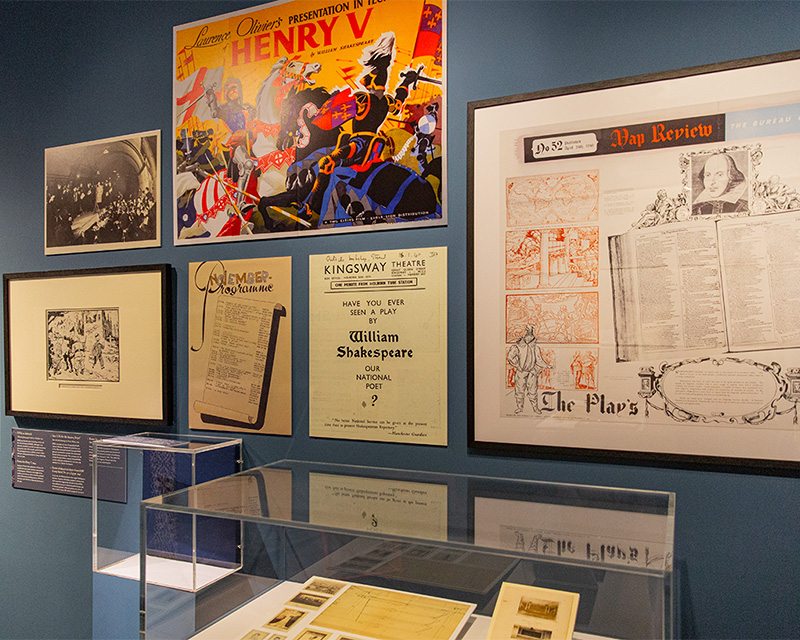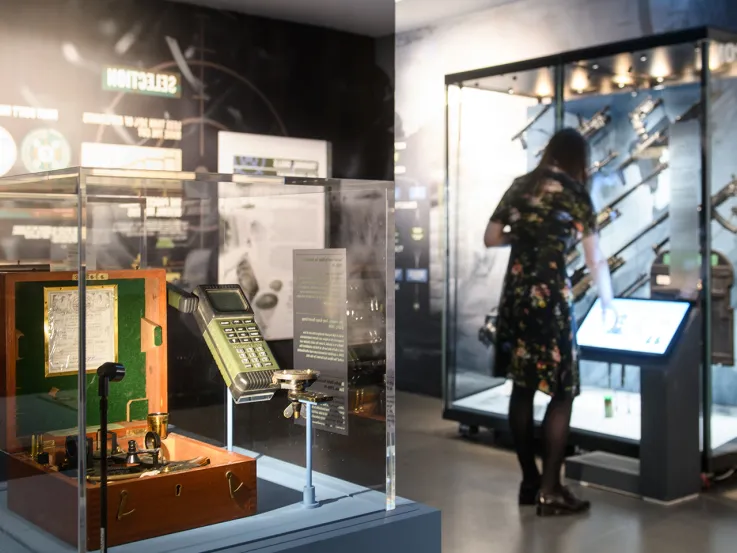Shakespeare and War exhibition opens at the National Army Museum

Monday, 15 April 2024
The National Army Museum’s new Shakespeare and War exhibition draws on objects and records from the British Civil Wars to the present day to explore how William Shakespeare’s famous plays have shaped attitudes about soldiers and the Army, and given new meaning to war and its consequences.
Through an intimate display of prints, drawings, video and audio of performances, the exhibition explores how Shakespeare has been used as an inspiration at times of war, by civilians on the home front and by soldiers on the battlefield.
War is a frequent theme of Shakespeare’s writing: from dramatic depictions of campaigns and battles to the soldiers who are major and minor characters in many of his plays. This theme has been used throughout time to reflect on war, help soldiers process their experiences, and help the public understand war and conflict.
Dr Glyn Prysor, Research Director at the National Army Museum, said:
‘We were thrilled to work with Dr Amy Lidster and Professor Sonia Massai to host this thought-provoking exhibition. Their insights have helped us see our collection in a fresh light and bring out new stories and angles on familiar history. As a fan of Shakespeare, it’s fascinating to see how the plays we know so well were viewed and interpreted through the lens of conflict.’
The exhibition explores how Shakespeare became a Royalist icon during the British Civil Wars after King Charles I read the Folio while in prison. He even wrote notes in the margins, renaming plays to reflect his frustration with his enemies. The display continues to explain how Shakespeare became more of a national icon, tied to Britain’s military victories around the world. This show illuminates different interpretations of these well-know plays, displaying them in a new light.
One remarkable find highlighted by the exhibition is that Shakespeare was as highly regarded in Weimar Germany as he was in Britain, and heralded by German society as ‘unser Shakespeare’, or 'our Shakespeare'. During the First World War, Shakespeare was claimed by both the British and German forces, and the exhibition showcases contemporary cartoons which evoke the struggle.
The exhibition ends on a poignant note, and reflects on recent productions inspired by Britain’s wars in Iraq and Afghanistan. A reproduction of a handwritten note left by Prime Minister Rishi Sunak during the 2023 G7 Summit in Hiroshima, where the first nuclear bomb was dropped during the Second World War. Sunak referenced Shakespeare’s words while considering the horrors of that war and its legacies.
Shakespeare and War has been curated in partnership with Dr Amy Lidster (Jesus College, University of Oxford) and Professor Sonia Massai (King’s College London). It draws on their edited collection 'Shakespeare at War: A Material History', recently published by Cambridge University Press.
Dr Amy Lidster said:
‘What surprised me the most in working on this project is just how often Shakespeare and his plays have been invoked at times of crisis and conflict. Shakespeare has been used to motivate troops, to reflect on the suffering of war, to influence political opinion, and to provoke through satire and propaganda. It has been thrilling to work with the National Army Museum and to find these stories richly embedded within their collection. Shakespeare doesn’t tell us what to think about war. Rather, we use Shakespeare to give our wartime experiences meaning. I am delighted that we’re able to bring some of these stories to life within this exhibition and accompanying book.’
Professor Sonia Massai said:
‘Before working on this project, I knew how Shakespeare represents war in his works, but I had little sense of how consistently and how diversely Shakespeare has been mobilised at times of war, on stage and on the page, by civilians on the home front and by soldiers on the battlefield. Some findings shocked me, others amused me, but all the material objects included in the exhibition and discussed in the accompanying book invariably moved me, because they fundamentally show us how Shakespeare has offered a space where the experience of being at war can be processed and those involved in it can begin to heal.’

Highlight objects
Radio recording from Shakespeare’s birthday, 23 April 1942
This is a radio recording of a programme originally broadcast by the BBC Overseas Services on Shakespeare’s birthday in 1942. It included extracts from 'As You Like It', 'Henry IV Part 1' and 'Henry V', and was introduced and performed by leading Shakespearean actors, Peggy Ashcroft, Robert Donat, Edith Evans and Ralph Richardson. Early 1942 was the nadir of the war for the British Empire, following the disastrous loss of Singapore.
Captain and Lieutenant-Colonel Henry Clinton, 1st Regiment of Foot Guards, c1758
During the American War of Independence, the British Army under the command of General Clinton, occupied New York City for most of the war. Members of the Army staged regular productions of Shakespeare at the newly renamed Theatre Royal, and appeared ‘with permission’ of Henry Clinton, who was also a patron of the performances. The military players tended to favour Shakespeare’s monarchical plays, while American Patriots used plays with a republican ethos (such as 'Julius Caesar' and 'Coriolanus') in their satirical prints and posters.
'Lord Kitchener's Appeal', recruiting poster, 1914 and ‘Printed sheet in memory of Lord Kitchener, drowned 5 June 1916’
Lord Kitchener and Shakespeare became linked during the First World War. Both were used to promote recruitment (as the famous ‘Your Country Needs You’ conscription poster showing Kitchener testifies). Kitchener and Shakespeare were also memorialised and used to commemorate the efforts of those who fought in the war. A striking example is the gift of the 'Kitchener Shakespeare', a complete edition of Shakespeare’s works that was presented to soldiers who had been blinded on the front.
‘Hamlet, King of Belgium’, from a special issue of 'Simplicissimus', April 1916
Shakespeare was a cultural battleground for Britain and Germany in the first World War, as both sides took Shakespeare’s plays as inspiration for their troops. In this German cartoon, ‘Hamlet, King of Belgium’ stands in a desolate landscape above a freshly dug hole in the ground. It alludes to a famous scene from the play, but also to trench warfare and the countless graves on the frontlines.
‘Tommy Bardolph’, from a special issue of 'Simplicissimus', April 1916
This German cartoon seems to offer a neutral image of Germany’s enemy. However, the title ‘Tommy Bardolph’ combines the slang name for a British soldier – Tommy – with the character of Bardolph from 'Henry V', a cowardly drunkard who is hanged for looting a church.
‘The Great Game’, appliquéd textile by War Boutique, 2011
This textile is made from the material of combat uniforms worn by British soldiers on campaign in Afghanistan from the time of the First Afghan War (1839-42) to the current Multi-Terrain Pattern. It is a striking object that symbolises the reflexive and probing use of Shakespeare both on stage and during military action.
Notes to editors
For more information, please contact:
- National Army Museum Communications Team: press@nam.ac.uk
About the National Army Museum
The National Army Museum shares the history and heritage of our soldiers and their service in the Army, across the globe and down the centuries. Through our collections we explore the history of the Army from its origins to the present day. We aim to engage and inspire everyone with the stories of our soldiers and how their service shapes our world; past, present and future.


